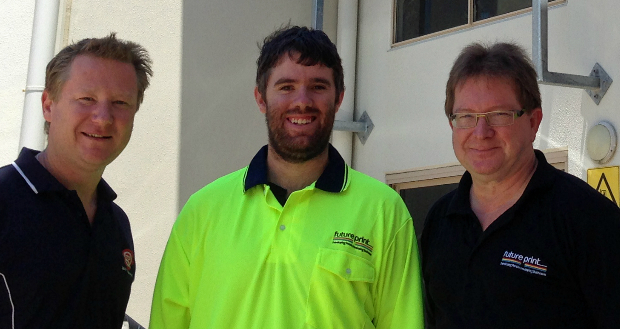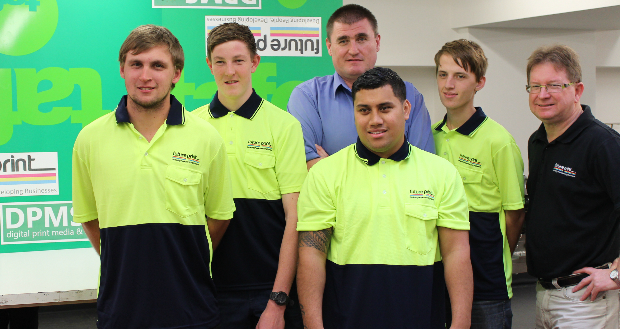

Future Print pioneers, l-r: Garth Austin, David Smith and John Scott, advisor with Queensland Future Print
Garth Austin, production leader with Queensland Trade Print on the Sunshine Coast, says the first Future Print apprentice is flying through his training and adding value to the business. David Smith, finishing apprentice, turned down an opportunity to undergo an apprenticeship two years ago as it would have required him to travel to Brisbane for trade school, and would have taken four years to complete. This time around the Future Print model has proved more attractive; allowing apprentices to learn on the job and graduate in 2.5 years. Smith was the first apprentice to sign up for the programme in the country. He says, “The Future Print training is perfect for me. It means I can learn here on the job in Warana, which is more convenient for me and also means we can fully staff both shifts. “With the knowledge and experience I have already gained over my time here, I should be able to complete my qualifications in about two and a half years, which is fantastic.”

Queensland Trade Print provides general commercial print from its Sunshine Coast plant
Smith has now completed his first training block and with ongoing competency-based assessments expects to complete his first year of training by September. Austin says, “The opportunity Future Print has provided for us and for David is invaluable, and we are delighted with the way he is progressing. “Training is vital and with the advantages offered by this new system, we already have another employee earmarked to start Future Print training as soon as we are able to make it happen.” Smith has been working in the family-owned printer’s finishing department for the past four years. Austin says offering him the opportunity to gain qualifications is an important way to ‘recognise his contribution, and invest in our business future.’ Austin says Smith’s existing knowledge base and experience is already of enormous value to the business, and once he has completed his apprenticeship it will mean there is another qualified print finisher available for production shifts. He says, “It can be difficult to find good tradespeople, particularly if you are not in one of the major cities, so training makes good sense for us. “Plus, it gives you the advantage of retaining good staff who already know your business, your clients and your operating environment. “We have always believed in training and the Future Print model has removed all the inconvenience from the equation, working out much better for David and for us.”
Comment below to have your say on this story.
If you have a news story or tip-off, get in touch at editorial@sprinter.com.au.
Sign up to the Sprinter newsletter



